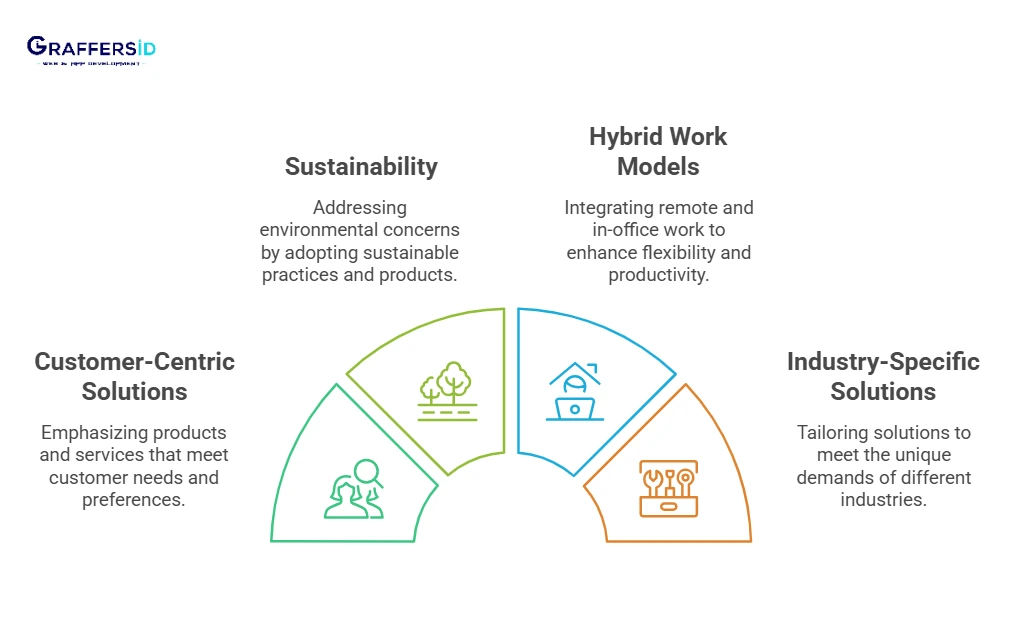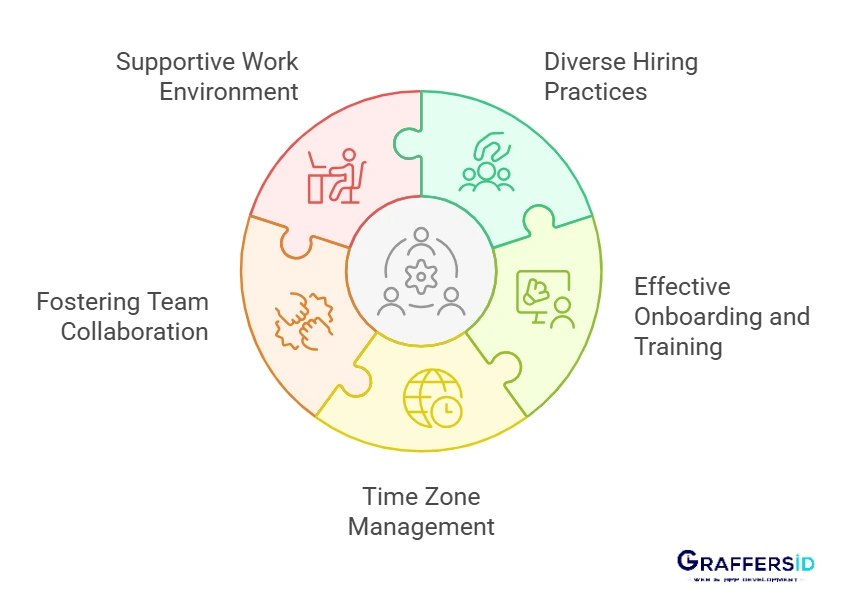As we enter 2025, it is essential for companies to align their strategies with growth. Remote development is increasingly becoming an essential factor for modern businesses. By adopting remote development, companies can stay ahead of the curve in the innovation race as they get access to the best talent from all over the world, all at an effective cost. In this blog, we will look at how organizations can future-proof their remote development strategy.
Identifying Emerging Technologies in Remote Development
Every day when you look at the news, you will find something related to emerging technologies and AI. These technologies are reshaping the way remote development teams work. New tools that help enhance productivity, collaboration, and code quality help developers increase productivity. So, it becomes important for companies to identify and adopt these technologies to increase efficiency.
Artificial Intelligence (AI) and Machine Learning (ML):
AI-driven tools like GitHub Copilot and Tabnine speed up the work of developers by suggesting pieces of code, automating debugging, and increasing general productivity. Machine-learning models may also study the past projects to predict hurdles, accelerate workflow, and suggest optimizations.
Cloud Development Environment:
Platforms such as AWS Cloud9 and GitHub Codespaces give developers the ability to access powerful and collaborative environments-from anywhere. These tools allow teams to work on complicated projects without requiring high-end local setups.
DevOps Automation:
Jenkins and Kubernetes are some tools that provide embedded automation along your deployment pipeline, which enables faster software delivery that is also trustworthy. The remote team can automate testing, monitoring, and scaling with the help of several other automation tools.
Collaborative Design Platforms:
Tools like Figma and Miro empower multiple remote developers to collaborate with designers and stakeholders. These platforms facilitate real-time updates, feedback, and brainstorming across geographies and time zones.
Read Also: Business Process Automation -What you Need to Know
Adapting to Changing Market Demands and Trends
Businesses that prioritize agility and adaption can easily jump on to new trends and cater to rising market demands. This converts into better products and increases customer satisfaction, as the products will align with the latest trends. For example, with AI becoming increasingly relevant in our lives, a tech company can develop new products for voice and video automation as customers look for tools to simplify these tasks.

Focus on Customer-Centric Solutions:
Your remote development teams should always focus on building products that will provide a solution for the problems of the customers. This requires a lot of research and development on the company’s part, as they need to evaluate trends and forecast demands for a potential product. If they focus on customer-centric solutions, it will automatically translate into customer loyalty and increased satisfaction.
Increased Demand for Sustainability:
Sustainability is becoming a popular norm for many companies as customers are prioritizing the environment. The demand for eco-friendly solutions is prevalent. For development teams to implement sustainability in their practices, they can adopt green coding practices, manage the application energy consumption, and use cloud services with sustainable policies. This will show that the company and their remote development team are conscious about the environment, and are contributing towards making it greener.
Hybrid Work Models:
Remote development models have remained a popular choice for employees. However, companies can also adopt hybrid working models as an alternative to fully remote setups. This setup might attract more talent as it combines the benefits of remote and in-house working models.
Industry-Specific Solutions:
Every industry around us is trying to develop products that are more innovative on the technology front. Tailored solutions for companies working in healthcare, finance, e-commerce, edtech, etc. are high in demand. Remote development teams should target specializing in technologies that might be relevant to these industries- like telemedicine portals for healthcare, chatbots for e-commerce, etc. In our previous blogs, we talked about how automation in various segments can help businesses stay ahead and perform repetitive tasks with minimal human intervention.
Investing in Scalable Remote Development Infrastructure
High-Performance Cloud Infrastructure:
When remote teams need to access tools and resources smoothly, investing in robust cloud services such as AWS, Microsoft Azure, or Google Cloud becomes essential. Scalable storage, virtual machines, and integrated services add fidelity to operations.
Collaboration and Communication Tools:
Communication and collaboration tools such as Slack, Zoom, and Notion cleanly convey information and smooth coordination. These platforms are integrated solutions for task management, video conferencing, and knowledge sharing.
Version Control and Code Management:
Platforms, such as GitHub, GitLab, and Bitbucket, help maintain workflow in code integrity and determination of version control. With the aid of these platforms, several developers can work concurrently on a project without conflict.
Cybersecurity Measures:
The protection of sensitive data is imperative for remote structures. Secure your remote access with tools like VPNs, MFA, and endpoint security.
Scalable DevOps Pipelines:
Containerization technologies such as Docker and Kubernetes ensure that scalability is maintained during deployment. These enable remote teams to take on more without sacrificing performance.
Building a Resilient Remote Team for Future Challenges

Diverse Hiring Practices:
With remote hiring, you can recruit talent from various regions and backgrounds, which inculcates innovation and adaptability. As the talent hails from different parts of the globe, each person brings a fresh perspective and skillset. A diverse team can tackle problems with creativity and different approaches.
Effective Onboarding and Training:
Fresh talent takes a considerable amount of time to familiarize themselves with company processes, culture, and environment. Invest time in ensuring that the onboarding process is comprehensive and complete so that the new hires can adapt quickly.
Time Zone Management:
There is a high possibility that the work schedules of many developers will overlap as they follow different time zones. To manage this gap, utilize asynchronous communication tools for seamless collaboration.
Fostering Team Collaboration:
Have your HR team frequently arrange virtual team-building activities, check-ins, and shared project ownership for the team to communicate and collaborate better. This build’s trust, rapport, and general camaraderie amongst them.
Supportive Work Environment:
Mental-health is directly proportional to the productivity of your team members. Ensure that everyone on your team has a healthy work-life balance. Grant leaves and breaks if they are feeling burnt out or stressed from excessive work.
Read Also: Implementing Contiuous Learning in Remote Development teams
Continuous Innovation: Staying Ahead in Remote Development
Encourage Experimentation:
Teams should regularly engage in experimenting with new tools and frameworks that help them stay up-to-date with the latest trends. When their talents are engaged in hackathons and innovation sprints, they might feel motivated to work on new and innovative ideas.
Adopt Agile Practices:
Development teams need to be quick on their feet and hence adopt agile methodologies for quick iteration, feedback response, and development of high-quality products. Several tools can facilitate this practice, like Jira, Trello, etc., and help implement agile methodologies.
Leverage AI and Analytics:
Teams can use AI powered tools that would help them track team performance, manage workflows, and forecast project outcomes. This can provide them with insights which will lead to smarter decision-making.
Partner with Tech Experts:
You can partner up with technology consultants or experts who can guide you with insights into emerging trends and technologies. On boarding experts for workshops or seminars every now and then can boost the knowledge of developers and accelerate innovation in your team.
Focus on Upskilling:
Motivate your developers to keep learning and upskilling by taking online courses, certifications, and engaging in general discussions with peer groups and seniors that will help them stay ahead of the industry trend.
Conclusion
With the help of the strategies discussed above, you can effectively manage your remote development teams. For developing quality products, it is important to have the right talent and to manage the right talent, certain organizational skills need to be adopted. A gap in this might lead to your employees feeling undervalued or disconnected from the company goal.
If you are looking to hire a remote development team or developers on contract, look no further. At GraffersID, we make your vision our mission. With talented developers on board, we assure you that there will be no gaps in the outcome. Let’s partner together and start growing!





